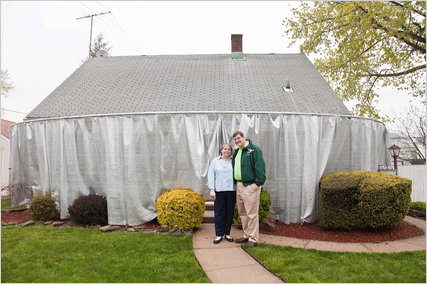By Brian Skeele, on May 9th, 2011
Washing machines sit idle most of the time
Looking at the challenge of how to build our futures resilient and sustainable, my sense is the insulation in the burbs across America is woefully shy. Heating systems are not so efficient, heating ducts leak, appliances are not so energy efficient, and windows are not so good, to say the least. These aren’t really economic problems until we hit global peak oil production. Then the pain of rising prices, utility bills, and commuting will become increasingly excruciating, is my guess.

What service would you like to provide to the neighborhood? Originally, the “dress” on House #1 was meant to conceal a gambling casino.
The cost of renovating a suburban home to a highly efficient passive (zero or low emissions) house is cost preventative in many situations. My sense is most suburbanites will only be able to make these upgrades if they can bundle the costs as they add a second, third, four stories to their homes. To make this scenario work, the first floor will become mostly commercial, home occupation, and the floors above will contain rentals, offices or residential, maybe multigenerational families with multiple contributions to the mortgage. The densities in the neighborhood have to be high enough to make the commercial successful.
I wouldn’t be surprised if the numbers for this “2-4 story smart density infill/renovation to passive home standards” will only work if these free standing suburban homes are joined to create row houses. My guess is the cost challenge of upgrading from an R 13 or R19 wall to a R 40? is too great a hurdle. By creating row houses, I’m thinking the amount of exterior walls is greatly reduced. Good sound insulation is essential, but much less expensive than getting to R 40 (or whatever a passive/zero emissions house design requires).
To add to the complexity,… these suburbia transforming strategies aren’t going to work in a piecemeal, unilateral fashion. A well thought out community planning process is necessary to satisfy all the neighbors, as well as the policy makers and investors.
Bankers/investors are going to want assurances the location for this loan is well thought out…the results of a community wide agreement as to where the community square, plaza, services, open space, schools, etc are located, such that the result is a walkable, sustainable, resilient, mixed use, mixed income community is created.
Shared amenities and facilities like washing machines, car shares, local food production season extending arrangements, work out facilities, parks, bike trails, aging in place strategies, downsizing in the hood, etc, etc are essential to making the numbers work, so it seems to me. Which is good news….collaborative consumption (a phrase I came across yesterday) is necessary to get our carbon footprint under control.
Inspired by the service-oriented mentality of New York, Open House by Droog led by Diller Scofidio + Renfro is a movement in which suburban homeowners supplement their income and develop a new vocation by offering home-made services and facilities to the public.
What I appreciate about the Open House Event, is it gets suburbanites thinking bigger. For them to sign off on transforming their neighborhood sustainable, they need to see all the benefits, a “compelling why” to offset their NIMBYism. They get more, they give more…the quality of life is appreciably better, more affordable with integrated renewable energy, local food, housing for farmers and their employees, vibrant alive pedestrian friendly streets, all kinds of great, creative endeavors, neighbors going for their creative dreams etc, etc.
In addition to suburbanites thinking bigger, we need great modeling tools so they can see all these benefits at the end of the planning sessions. The city bureaucrats will see the infrastructure costs vs the increase in property tax revenues.
Also, these neighborhoods need to fit into the regional water sheds, food sheds, energy sheds, transportation plans, and habitat preserves, etc.
What Services would you like to offer your neighborhood? Share them here!! together we can make sustainable real!!
Image courtesy of New York Times
